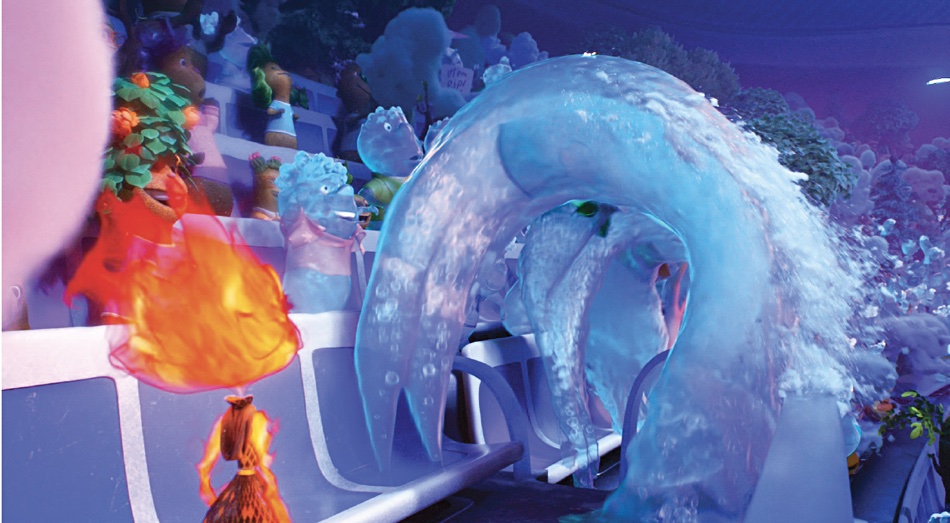VAST Data’s single tier flash storage has been used by Pixar to feed data to the 150,000 cores needed to render the Elemental movie – six times more cores than Pixar needed for its previous film, Soul.
Pixar is an animation studio owned by Disney. Elemental is viewable in US theatres from June 16 onwards, and is a romantic story showing relationships between cartoon characters who represent different elements such as earth, air, fire and water, who live in Element city, and whose intrinsic nature means they cannot mix. But hey – this is a movie and anything is possible.
Eric Bermender, head of data center & IT infrastructure at Pixar, said. “Elemental is the most technically complex film that Pixar has ever made.” It was developed with “new techniques that no one had ever considered before because we didn’t have the technology in place to support it.”

Pixar had to develop new visual effects algorithms to render the characters in the movie and, Bermender said, “VAST’s technology has allowed us to change the way we store and access data while also opening the door to new potential visual pipelines.”
Pixar uses its own Renderman software to compute the color of every pixel in every frame of its 3D animated movies.
Typically, an object’s surface is made out of triangles, with the three defining points being in the same plane. Computer special effects characters, such as the clone army fighters in Star Wars: Episode II – Attack of the Clones, are generally solid in that they have non-transparent surfaces and clear boundaries between them and their background. Their surfaces are represented by thousands – maybe hundreds of thousands – of connected triangles which are given pixel values.

They are movable objects which have shape and texture and color, and on which light shines and reflects. The video effects software, when rendering these movable objects for a frame in the movie, needs to model the effects of light on hundreds of thousands of such surface items for each object (character).
Volumetric rendering is different. In general, volumetric rendering is used to display in 2D a set of individual 3D samples from a 3D volume – such as a CAT scanner. The process needs to define the opacity and color of very data point on the 3D grid formed by the samples – voxels in the trade. Such voxels could be given RGBA (red, green, blue and alpha) values and then projected onto a pixel in a frame buffer.
Getting back to Elemental, the characters, made of fire and water, are translucent and don’t have clearly defined surfaces. Light rays that hit the characters pass through them – they are only partly reflected. As a Pixar document explains: “The boundary behavior of the volume containers is not relevant to the render: rays will not bend.”

This means that, if we were to imagine a succession of vertical 2D slices through them, all the pixels on the slices would have color and be visible, to an extent, behind the slices in front of them from the camera’s viewpoint. That makes the computation of the overall object’s pixels on a 2D screen much more complex.
Each of the surface triangles involved in the previous type of rendering would have to have their pixel values affected by the succession of interior pixel values behind them, as it were – increasing the number of individual pixel values involved in the computations enormously.
Pixar said that, unlike the geometric surfaces and materials used in earlier Pixar projects such as Soul, the volumetric animation methods used in Elemental created six times the data footprint and computational demands for data. There were, we’re told, 150,000 volumetric frames in Elemental.
The 150,000 compute cores used to render the movie needed access to an overall 7.3PB of data in a cluster of VAST Data storage nodes using a single namespace. The Soul movie needed a mere 24,000 cores in comparison.
At peak rendering usage time, the VAST cluster had to provide direct access to 2PB of data – whereas previous Pixar movies needed access to just 300 to 500TB of capacity. And the VAST storage kit was also being used by artists at Pixar working on other movies at the same time.
Jeff Denworth, co-founder of VAST Data, said: “For Elemental and future films, we’re delivering a data platform that powers the animation and rendering workflows for their most data-intensive and computationally heavy projects, while enabling its AI and ML pipeline for the future in order to further the ambitions of Pixar artists and the stories they’re able to tell.”
Soul was not as successful as either DIsney or Pixar hoped. Elemental will, hopefully, restore Pixar’s reputation for producing great animated movies.
A Pixar report discusses the volume rendering in Elemental in more detail if you want to find out more. It discusses how Pixar updated and developed earlier volume rendering approaches to work on Elemental.








